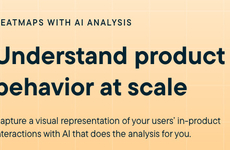
Google's Heatmaps Help Content Creators See Where Viewers are Looking
Laura McQuarrie — June 21, 2017 — Tech
References: youtube-creators.googleblog & wersm
For the benefit of virtual reality content creators, Google launched a new tool that allows uploaders to view heatmaps in order to determine where their viewers are looking. This new feature is available for 360-degree and VR videos with over 1,000 views, making it possible to pinpoint exactly where a viewer's attention goes over the course of a virtual experience.
Although virtual reality experiences give viewers the chance to fully immerse themselves in a 360-degree environment, in its early research Google remarks that: "surprisingly, people spent 75% of their time within the front 90 degrees of a video." This insight alone reveals that content creators must engage viewers with animations or actions that call them to look at different parts of the virtual world.
Although virtual reality experiences give viewers the chance to fully immerse themselves in a 360-degree environment, in its early research Google remarks that: "surprisingly, people spent 75% of their time within the front 90 degrees of a video." This insight alone reveals that content creators must engage viewers with animations or actions that call them to look at different parts of the virtual world.
Trend Themes
1. Virtual Reality Heatmaps - Use of heatmaps in virtual reality videos to track viewer attention and optimize content.
2. Enhanced Viewer Engagement - Focus on creating animations or actions in virtual reality videos to encourage viewer exploration.
3. Data-driven VR Content Creation - Utilize heatmaps and viewer data to inform the creation and placement of content in virtual reality experiences.
Industry Implications
1. Virtual Reality Content Creation - Content creators can leverage heatmaps to enhance the immersive experience and maximize viewer engagement.
2. Digital Advertising - Advertisers can use heatmaps to strategically place ad content within virtual reality videos to capture viewer attention.
3. Market Research and Analytics - Companies can analyze heatmaps and viewer data to gain insights into viewer preferences and behavior within virtual reality experiences.
3.5
Score
Popularity
Activity
Freshness























